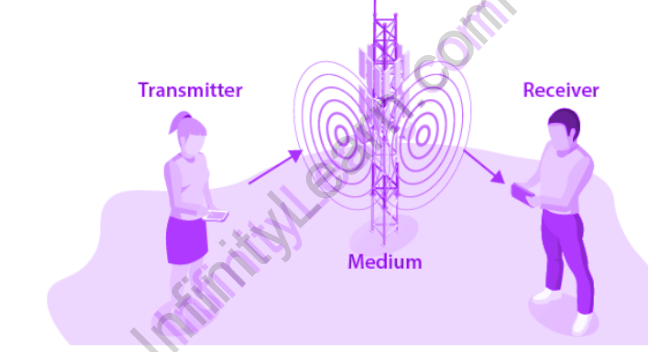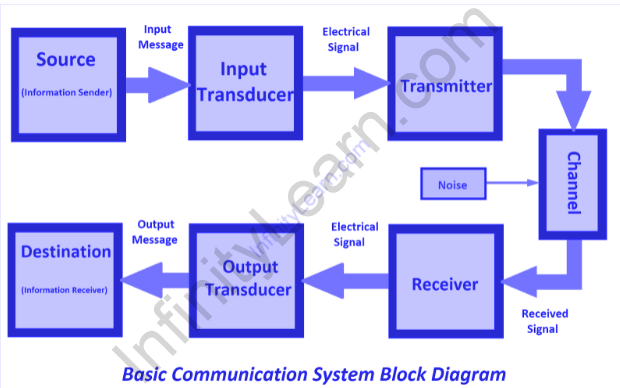Table of Contents
A communication system, also known as a communications network, is a collection of individual telecommunications networks, transmission systems, relay stations, tributary stations, and terminal equipment that can be interconnected and interoperated to form an integrated whole. The components of a communications system have a shared goal, are technically compatible, follow standard procedures, respond to controls, and collaborate. The term “telecommunications” refers to a sort of communication (e.g., for sports broadcasting, mass media, journalism, etc.).
The act of communicating intentional meanings from one entity or group to another using mutually understood signals and semiotic norms is known as communication. An optical communication system is any type of telecommunication that employs light as a medium of transmission. A transmitter encodes a message into an optical signal, a communication channel delivers the signal to its destination, and a receiver reproduces the message from the received optical signal to make up the equipment. Fibre-optic communication systems send light through an optical fibre to transmit data from one location to another. The light creates a carrier signal, which is modulated to carry data.
A radio communication system is made up of several communications subsystems that enable external communication. A radio communication system consists of a transmitting conductor that generates electrical oscillations or currents and is designed to transmit those frequencies or oscillations through the free space of the space from one point to another remote from the transmitter, as well as the receiving conductor at such a distance. modified to accelerate the oscillations or waves transmitted to the transmitter.
Power cable communication systems work by transmitting a network signal to a switch over power cables. Depending on the signal transmission characteristics of the power wiring used, different types of powerline communications use different frequency bands. Because the power wiring system was designed to transmit alternating current (AC), the power wire circuits have a limited ability to carry higher frequencies. The propagation problem stymies all types of power line communications.
Don’t Miss: JEE Main 2025 Paper Analysis (22nd Jan) Shift 1 & Shift 2 | JEE Main 2025 Paper Analysis (23rd Jan) Shift 1 & Shift 2 | JEE Main 2025 Paper Analysis (24th Jan) Shift 1 & Shift 2 | JEE Main 2025 Paper Analysis (28th Jan) Shift 1 & Shift 2 | JEE Main 2025 Paper Analysis (29th Jan) Shift 1 & Shift 2

Basic Elements of Communication System Overview
The communication system is a model of a communication exchange between two stations, transmitter and receiver. A channel is used to send signals or information from one location to another. It represents a method by which the signal moves from a source to its destination. To transmit signals in a communication system, they must first be processed, beginning with signal representation and progressing through signal shaping, encoding, and modulation. After the transmitted signal has been prepared, it is routed to the channel’s transmission line. As a result of signal crossing this medium, it suffers from a variety of impairments such as noise, attenuation, and distortion. The process of exchanging information between two sites is referred to as communication. The transmitter sends the information, the medium sends the information, and the receiver receives the information on the other end are the main elements required for communication. Communication systems include things like line telephony and telegraphy, radiotelephony and telegraphy, radio broadcasting, point-to-point communication and mobile communication, computer communication, radar communication, television broadcasting, radio telemetry, radio aids to navigation, radio aids to aircraft landing, and so on.
Communication, in its most basic form, entails the transmission of information from one point to another via a series of processes, as listed below:
- The creation of a thought pattern or image in the mind of the creator.
- A set of oral visual symbols is used to describe that image with a certain degree of precision.
- The encoding of these symbols in a format suitable for transmission over an interesting physical medium.
- The delivery of encoded symbols to their intended destination.
- The process of decoding and reproducing the original symbols.
- The recreation of the original thought pattern or image in the recipient’s mind, with a discernible degradation in quality.
Watch Session on Our YT Channel
Types Of Communication Systems
The communication system is classified as follows based on signal specifications or technology:
(1) Analogous
Analog technology transmits data in the form of electronic signals with varying frequencies or amplitude. Analog technology is commonly used in broadcast and telephone transmission.
(2) Electronic
In digital technology, data is generated and processed in two states: high (represented as 1) and low (represented as 2). (represented as 0). Data in the form of 1s and 0s is stored and transmitted by digital technology.
The communication system is classified as follows based on the communication channel:
1. hardwired (Line communication)
- Communication via parallel wires
- Communication via twisted wire
- Communication via coaxial cable
- Communication via optical fibre
2. radio-frequency (Space communication)
- Communication via ground waves
- Communication via the skywave
- Communication via space waves
- Communication via satellite
Watch JEE Related Session Videos on Our YT Channel
| Title | Links |
| My Jee Preparation Journey: How I cracked IIT | Click Here |
| most important questions and concept of chemistry from high weightage chapters | Click Here |
| NTA Based Full Maths Paper Predictor | Click Here |
| Low Marks in Mocks? Stuck? Here’s How to Increase Your Score | Click Here |
| Full Revision – Mechanics (Linear + Rotational) – must do problems | Click Here |
| JEE Main 2025 | Last 20 Days Strategy to Score 150+ in Jan Attempt | JEE 2025 | Click Here |
| Menti Maths Vs Chemistry: Full Syllabus Mock Test | Click Here |
| Last 10 Days Strategy For Jee Main 2025 Jan Attempt | Click Here |
| NCERT Challenger for JEE Mains 2025 (20 Best Questions of GOC) – Newly framed & Best PYQ | Click Here |
| Test Your Preparation – Gravitation – Challenging Questions for JEE 2025 | Click Here |
| Jee Advanced Questions Important For Jee Main 2025 | Click Here |
| D & F Block in one shot – Newly framed & Best PYQ for JEE Mains 2025 | Click Here |
| Electrostatics – Questions to boost your rank – Part 1 | Click Here |
| Jee 2024 Most Repeated Questions From All 20 Shifts | Click Here |
| Mock test for Complete Inorganic Chemistry – 1 (for JEE Mains 2025) | Click Here |
| Expected Marks Vs Percentile For Jee main 2025 Jan Attempt | Click Here |
| 12 Hours Marathon | Complete Organic Chemistry | Last Minute Revision | Click Here |
| Jee Main 2025 January Attempt Paper Prediction | Click Here |
| Dual Nature of Radiation and Matter | Click Here |
| Which Attempt is Important Jan Or April ? | Click Here |
| 300 Most Expected JEE Mains 2025 Questions |Non Stop 6 Hours Marathon | Paper Predictor | Part 1 | Click Here |
| 300 Most Expected JEE Mains 2025 Questions |Non Stop 6 Hours Marathon | Paper Predictor | Part 2 | Click Here |
| 300 Most Expected JEE Mains 2025 Questions |Non Stop 6 Hours Marathon | Paper Predictor | Part 3 | Click Here |
| 300 Most Expected JEE Mains 2025 Questions |Non Stop 6 Hours Marathon | Paper Predictor | Part 4 | Click Here |
Block Diagram of Communication System
The design and circuitry of a real-world communication system are determined by its type, distance, channel, signal types, and so on. However, if we look at the fundamental components of any communication system, we can see that they are,
- Source or Information Sender
- Input Transducer
- Transmitter
- Channel
- Receiver
- Output Transducer
- Destination or Information Receiver

- Source
The source is the location from which the sender sends the physical message. It could be a voice, pictures, text, video, or something else. The communication system assumes full responsibility after the sender has sent or provided the message or information. The communication system should now deliver those messages to their intended recipient.
- Transducer for Input
The first and most important component of a communication system is the input transducer. It converts the sender’s physical messages into electrical signals. A transducer is a device that can convert physical quantities into electrical quantities or electrical quantities into physical quantities. In essence, the input transducer converts physical quantities into electrical quantities. A microphone, for example, is a transducer that converts voice into an electrical signal and is widely used in communication systems. A transducer is also something like a camera.
- Transmitter
The transmitter is a device or circuit that prepares the signal for long-distance transmission. If the communication system is large, a transmitter can be a large or complex circuit. A transmitter performs a variety of critical functions. It modulates the signal with the help of a carrier signal. It boosts the signal’s strength to allow for long-distance communication. It is necessary to convert the signal. For example, if the signal is to be transmitted via electrical conductors or lines, no conversion is required; simply amplification is sufficient. However, if the signal is to be sent through space, the transmitter will convert the electrical signals into radio waves. If the signal is to be sent via fibre optic cable, the transmitter will convert the electrical signal into light or optical signal.
- Channel
The transmission channel is the medium used to send messages or information over long distances. Different types of signals are used by the various channels. If the channel is an electric conductor, information is transmitted in the form of electrical or electronic signals. If the channel is an optical fibre cable, the information is transmitted in the form of an optical signal. If the channel is empty, information travels in the form of radio waves or microwaves.
- Receiver
A receiver is a device or circuit that receives the signal after it has travelled a long distance through the channel. A receiver’s input signal can take any form, such as an electrical, optical, or electromagnetic wave. However, the receiver only outputs electrical signals. A receiver’s functions are to receive the signal, remove noise or distortion, demodulate if necessary, convert, and amplify.
- Transducer of Output
The electrical signal is converted by the output transducer into the actual message or information in the form of a physical quantity. The speaker, for example, converts an electrical signal into sound. As a result, the receiver at the destination station can hear what the sender at the source station is saying.
- Destination
The destination is the point at which the communication system comes to an end and the receiver receives the actual message or information.
Make your IIT Dream come true with Infinity Learn.
FAQs
What is the definition of a communication channel?
A communication channel is a medium through which a signal can be transmitted. Electrical signals travel through two types of media: guided and unguided. A guided medium is one that is directed from transmitter to receiver via connecting cables. Examples include coaxial cables, telephone wires, twisted pairs, and other guided media. On the other hand, Unguided media refers to any communication channel that creates space between the transmitter and receiver. Air is the only medium between the transmitter and the receiver for radio communication. Everything from the vacuum of space to solid pieces of metal can be used as communication channels.
Question What exactly is a communication system, and what are some examples?
The exchange of information between two points is communication. The communication system is the system that describes this process. Communication consists of three major components: the sender, the receiver, and the information. The medium is used to transmit information, and the receiver is used to receive it. The following are some communication system examples: The Internet is a global network of interconnected computers, mobile phones, laptop computers, and other devices. An IP address, also known as an internet protocol address, is assigned to each device. A public switched telephone network (PSTN) is a collection of telephone networks. Telephone operators run them on a local, national, and regional scale.
What components makeup communication systems?
A communication system is a system that allows information to be exchanged between two points. It consists of three basic elements: the transmitter, the medium of exchange, and the receiver on the other end, signal, transducer, amplifier, modulator, antenna, noise, and so on.









